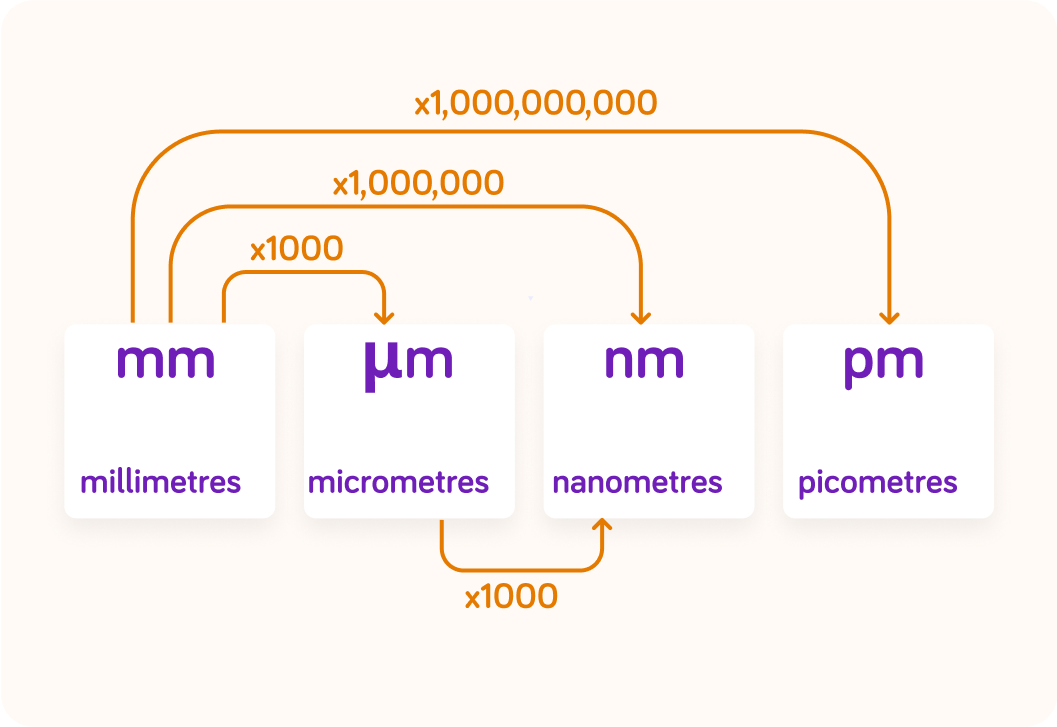YOU ARE LEARNING:
Tiny Units

Tiny Units
Cells are super small, so it's helpful to know some units that are smaller than millimetres.
A typical cell is 0.01−0.1 mm across. How many cells does that mean you can fit next to each other within a millimetre?
A) 1 cells B) 1-10 cells C) 10-100 cells


Imagine you are studying a cell that is 0.02 mm across
Those zeros and decimals could get quite confusing, so it's useful to use units that are even smaller than a millimetre.

Pick all the units below that you think are smaller than a millimetre.

You can select multiple answers
Micrometres are abbreviated μm
You can fit 1,000 μm inside a millimetre!

Now, imagine a cell that's 0.02 mm across. If you changed the unit to micrometres, would the number then be bigger or smaller than 0.02?
A) Bigger B) Smaller


To convert 0.02 mm into micrometres, you need to _____________ 0.02 by 1,000μm.
A) multiply B) divide


What is 0.02 mm in micrometres?


For every 1 mm, you have 1,000 μm
So you go from millimetres to micrometres by multiplying by 1,000 μm For example, 0.02 mm is the same as 20 μm

What is the abbreviation you use for nanometres?
A) μm B) nm C) pm


Nanometres are even smaller than micrometres
There are 1,000,000 nm in a millimetre!

So how would you change 0.02 mm into nanometres?
A) Multiply by 1,000 nm B) Multiply by 1,000,000 nm


What would 0.02 mm be in nanometres?


For every 1 mm, you have 1,000,000 nm
So you go from millimetres to nanometres by multiplying by 1,000,000 nm For example, 0.02 mm is the same as 20,000 nm

What is the abbreviation you use for picometres?
A) μm B) nm C) pm


Picometres are even smaller than nanometres
There are 1,000,000,000 pm in a millimetre!

So what would 0.02 mm be in picometres?


For every 1 mm, you have 1,000,000,000 pm
So you go from millimetres to picometres by multiplying by 1,000,000,000 pm For example, 0.02 mm is the same as 20,000,000 pm

Recap
Micrometres, nanometres and picometres are all smaller than a millimetre
Micrometres are abbreviated μm
Nanometres are abbreviated nm
Picometres are abbreviated pm
These are tiny tiny units!
There are 1,000 μm in a millimetre. There are 1,000,000 nm in a millimetre. There are 1,000,000,000 pm in a millimetre.
Now! For every 1 mm, you have 1,000μm and 1,000,000 nm. How many nanometres does that mean you can fit in a micrometre?


So you can fit 1,000 nm in one micrometre. How would you change for example 25 μm into nanometres?
A) Multiply by 1,000 nm B) Multiply by 1,000,000 nm


What would 25 μm be in nanometres, then?


For every 1μm, you have 1,000 nm
So you go from micrometres to nanometres by multiplying by 1,000 nm For example, 25 μm is the same as 25,000 nm

How would you convert from nanometres to picometres?
A) Multiply by 1,000 pm B) Multiply by 1,000,000 pm C) Multiply by 1,000,000,000 pm


How would you convert from micrometres to picometres?
A) Multiply by 1,000 pm B) Multiply by 1,000,000 pm C) Multiply by 1,000,000,000 pm


Now! How would you convert from nanometres to millimetres?
A) Multiply by 1,000,000 nm B) Divide by 1,000,000 mm


Make sure you know if you are going to a smaller unit or to a bigger one!
If you go from bigger to smaller, you should multiply (for example from millimetres to micrometres).
If you go from smaller to bigger, you should divid****e (for example from picometres to nanometres).

What would 0.035 mm be in micrometres?

What would 75 μm be in picometres?

What would 47 pm be in nanometres?

Summary! Cells are only about 0.01−0.1 mm across
So it's useful to have smaller units so you don't have to deal with all those zeros and decimals.

Micrometres, nanometres and picometres
There are 1,000 μm in a millimetre. There are 1,000,000 nm in a millimetre. There are 1,000,000,000 pm in a millimetre.

Be careful when you convert from one unit to another!
If you go from a bigger unit to a smaller unit, you should multiply. If you go from a smaller unit to a bigger unit, you should divide.

